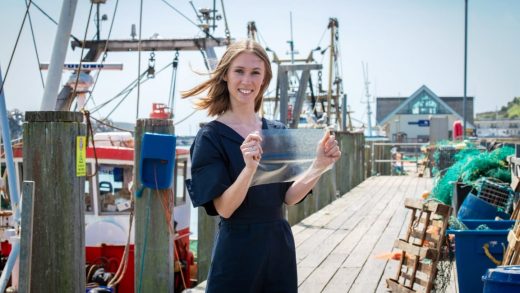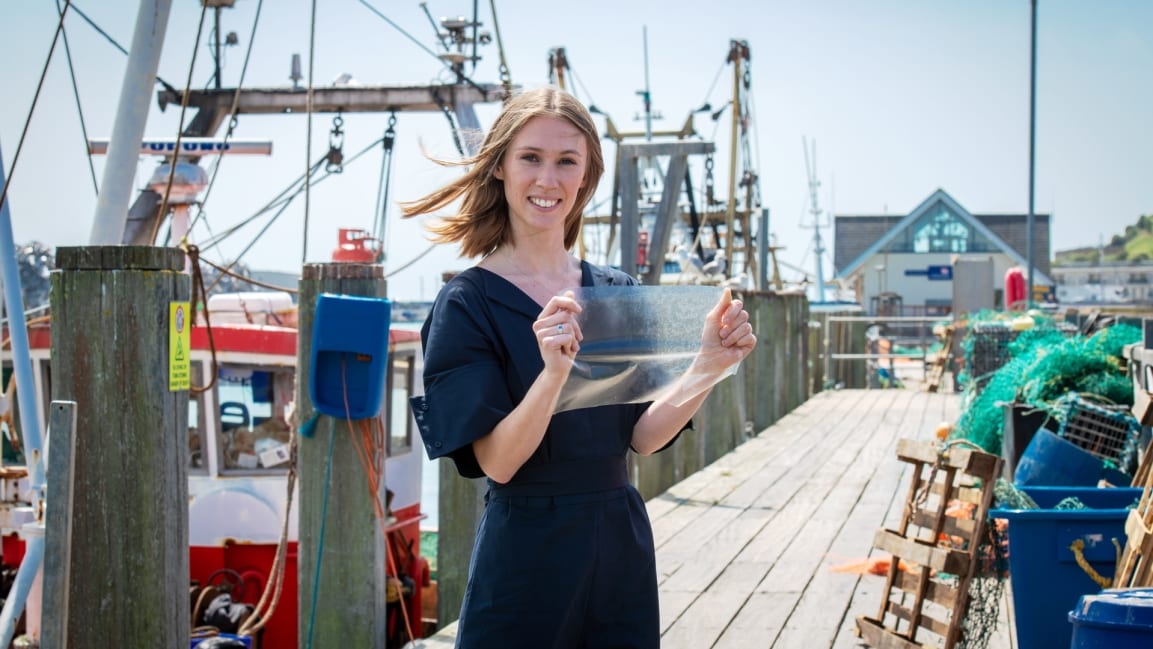This plastic-like packaging is made from fish skin and algae
This new packaging prototype looks like conventional plastic, but it’s actually made from fish waste and algae—and unlike plastic, if it escapes into the ocean, a fish could likely eat it safely. The material, called MarinaTex, is the winner of this year’s James Dyson Award.
“It began with my desire to work with waste,” says Lucy Hughes, a recent graduate from the U.K.’s University of Sussex, who began developing the material as a student. Through a contact at the university, Hughes visited a fish processing plant to see the massive quantity of waste generated by the industry and find new ways to use it. She focused on fish skins and scales. “When I had it in my hands, I realized this has got potential,” she says. “It’s super strong and flexible and pliable.”
Hughes spent months experimenting with fish waste in her kitchen, running more than 100 experiments to find a binder and a process that could hold together the proteins in the fish skins and scales. “I had a lot of failed attempts—a lot of things either went too brittle or too gooey or somewhat moldy,” she says. She finally landed on a type of algae that can be locally sourced.
The material can be used to replace oil-based plastic in packaging such as bags or the translucent windows used to show products in boxes. As her research continues, Hughes says that she’ll be studying how MarinaTex works as a barrier and how long it could be used to store food.
Unlike some “compostable” plastics, which need to be processed in an industrial composting facility to break down, the new material can break down in four to six weeks in a backyard compost bin. “All the ingredients are food-grade safe,” Hughes says. “So this degrades much like a piece of food would degrade.” If it accidentally washed into the ocean and a turtle or fish ate it, it wouldn’t cause problems. “I’ve yet to work out the nutritional value for fish,” she says. “But the core ingredients are proteins from fish and algae, so that’s already kind of the diet of a fish anyway.”
The research is at an early stage, but Hughes has calculated that the material could be cost-competitive because it can be processed at low temperatures, saving energy compared to plastic production, and because it starts with waste products rather than oil. The waste from a single Atlantic cod can produce 1,400 bags.
Hughes plans to continue R&D and patent the product as she prepares for manufacturing. Already, she says, she’s had interest from big brands and supermarkets. Many major companies are working on finding alternatives to plastic; more than 400 companies have signed the Ellen MacArthur Foundation’s Global Commitment, a pledge that says that any plastic that can’t be eliminated should be recycled, reusable, or compostable, and that recycling, reuse, and composting actually happens in practice. Hughes believes that eliminating plastic and shifting to reusable packaging should come first, but because behavior change is slow, this type of sustainable alternative for plastic also makes sense. “My main focus is to replace single-use [packaging],” she says.
(54)



